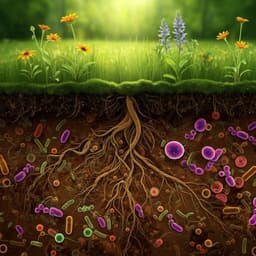
Environmental Studies and Forestry
Above- and belowground biodiversity jointly tighten the P cycle in agricultural grasslands
Y. Oelmann, M. Lange, et al.
Discover how increasing biodiversity can not only enhance grassland productivity but also reduce the need for fertilizers. This vital research by Yvonne Oelmann and colleagues demonstrates the ecological and economic benefits of promoting diverse plant and fungal communities, crucial for sustainable farming and combating biodiversity loss.
Playback language: English
Introduction
High biodiversity has been shown to increase ecosystem functioning and service provision. Increased productivity in plant species mixtures compared to monocultures is attributed to facilitation and niche complementarity, leading to more complete resource exploitation. Nutrients like nitrogen (N) and phosphorus (P) are more exhaustively exploited with increasing plant diversity, reducing N leaching to groundwater. However, P leaching wasn't similarly reduced, partly due to P's lower water solubility, forcing plants to develop alternative acquisition strategies beyond root uptake from soil solution. This low soil solution P concentration makes studying biodiversity's effects on the P cycle challenging, despite P's importance as a limiting nutrient, especially with high N deposition and decreasing mineral P fertilizer availability. Unlike N, P acquisition in temperate zones is largely linked to mycorrhizal fungi symbiosis (AMF in grasslands, EMF in forests), involving direct P transfer from fungus to plant. Plant and fungal species richness and identity influence productivity and potentially P transfer. Indirect P transfer via the microbial community (release during turnover or enzymatic release from organic matter) also plays a role. Since all three processes (fungal, microbial, and enzyme-mediated P release) increase with plant species richness, the study hypothesizes that biodiversity effects on the P cycle are mediated by plant-microbe interactions. While the mechanisms are partially understood in controlled experiments, it's unknown if they apply to managed agroecosystems like agricultural grasslands. Biodiversity experiments with management manipulations show that positive biodiversity effects on productivity persist despite management effects. However, seeded species composition changes with management. In long-established grasslands, biodiversity and management interact strongly, with management acting as an environmental filter on community composition. High management intensity, associated with high resource availability, reduces plant and AMF richness, favoring highly productive, exploitative species. This study aims to determine if resource exploitation is dominated by biodiversity or management effects in agricultural grasslands, combining data from a biodiversity experiment and observational data from agricultural grasslands located on calcareous bedrock, representative of Central Europe. The study focuses on P exploitation (P stored in biomass) relative to the total bioavailable P pool (organismic P stocks + bioavailable P in soil). It tests the mechanisms in the biodiversity experiment and explores if they persist along a management gradient using structural equation modelling (SEM).
Literature Review
Previous research has established a positive correlation between biodiversity and ecosystem functioning, particularly regarding nutrient cycling. Studies have shown that increased plant species richness leads to more efficient uptake of nitrogen (N), resulting in reduced N leaching. However, the relationship between biodiversity and phosphorus (P) cycling is less clear, partly due to the complexities of P's soil chemistry and its uptake mechanisms. The role of mycorrhizal fungi in P acquisition has been highlighted, with studies demonstrating a link between fungal diversity and plant growth and P uptake. The indirect role of soil microbes in P mobilization, through processes like organic matter decomposition and microbial turnover, has also been investigated. Existing literature suggests a strong interplay between plant diversity, microbial communities, and P cycling, although the precise mechanisms and their applicability to real-world agricultural systems remain unclear. This gap in knowledge necessitates further research, particularly concerning the interactions between biodiversity and management practices in managed grasslands.
Methodology
This study combined data from two sources: a biodiversity experiment (Jena Experiment) and observational data from 100 permanent agricultural grasslands along a management gradient within the Biodiversity Exploratories program. Both sets of grasslands were located on calcareous bedrock soils. The Jena Experiment involved 76 grassland mixtures with varying plant species richness (1-16 species), representing different functional groups, and a standardized management regime (mowing twice yearly, no fertilization). The agricultural grasslands represented a gradient of management intensity (fertilization, mowing, grazing), measured annually via farmer questionnaires. Data collection included plant species richness and biomass, soil samples for various analyses (organic carbon (Corg), soil pH, different P fractions using a sequential extraction scheme, microbial P using hexanol fumigation), and AMF species richness and abundance using DNA extraction and amplicon sequencing. Structural Equation Modelling (SEM) was used to analyze the data. An a priori defined mechanistic model of biodiversity effects on P exploitation was first tested on the Jena Experiment data. This model included variables known to influence P exploitation: soil organic carbon (Corg) stocks, AMF species richness and abundance. The model was then applied to the agricultural grassland data, including management intensity as an additional variable. Model optimization involved including additional paths to improve the model fit to the data. Statistical analyses included Pearson correlations and confirmatory path analyses using piecewiseSEM in R, accounting for the experimental design (block design for the Jena Experiment, regions for the agricultural grasslands). Spatial autocorrelation was checked to ensure independence of data points. Data was transformed when necessary to meet assumptions for statistical tests.
Key Findings
In the Jena Experiment (biodiversity experiment), P exploitation was positively related to plant species richness. This relationship was mediated by Corg stocks and microbial P stocks in soil. Increased plant diversity led to higher Corg stocks due to increased plant litter input, which in turn enhanced microbial P uptake and storage. Plant P stocks also increased with plant species richness, reflecting increased biomass production. However, the AMF symbiosis did not directly impact plant P stocks; instead, microbial P turnover likely played a larger role in replenishing the available P pool. In the agricultural grasslands, the SEM revealed a complex interplay between biodiversity and management. Management intensity had a direct positive influence on plant P stocks (likely due to fertilizer input) and Corg stocks. It also negatively impacted plant species richness, reflecting environmental filtering effects. Importantly, even in the agricultural grasslands, plant species richness remained positively linked to P exploitation. However, the mechanism was different from the Jena Experiment, suggesting unmeasured mediating variables were at play. Lower management intensity was associated with higher AMF species richness and abundance, and this higher AMF abundance was linked to increased P exploitation. Overall, management effects often overrode or modified the plant diversity effects seen in the Jena Experiment. However, reduced management intensity consistently benefitted above- and belowground biodiversity and improved P resource exploitation. The combined effect of AMF and plant species richness on P exploitation was significantly negative under higher management intensity.
Discussion
The findings demonstrate that both aboveground (plants) and belowground (mycorrhizal fungi) biodiversity contribute to a tighter P cycle in agricultural grasslands, even when management practices significantly impact other aspects of the system. The contrasting mechanisms observed between the biodiversity experiment and agricultural grasslands highlight the complex interactions between biodiversity, management, and nutrient cycling. The results support the notion that preserving and enhancing biodiversity can lead to more efficient nutrient use in agricultural systems, potentially reducing the need for fertilizers, while simultaneously offering ecological benefits. The positive relationship between plant species richness and P exploitation in agricultural grasslands, irrespective of the altered mediating mechanisms, suggests the inherent value of plant diversity in improving nutrient cycling. However, it also underlines the need to understand the specific mechanisms operating under diverse management conditions. Future research should focus on integrating detailed microbial community data, functional gene analysis, and soil properties to improve the mechanistic understanding of these relationships.
Conclusion
This study provides strong evidence for the synergistic role of above- and belowground biodiversity in enhancing P cycling in agricultural grasslands. While management practices can significantly affect the mechanisms underlying this relationship, the overall positive effect of biodiversity on P exploitation remains evident. The findings underscore the potential for biodiversity-friendly agricultural practices to improve nutrient use efficiency and reduce reliance on fertilizers, offering both ecological and economic benefits. Further research incorporating high-resolution analyses of microbial communities, functional gene expression, and other soil properties is crucial for improving the mechanistic understanding of these complex interactions and for informing the development of sustainable agricultural management strategies.
Limitations
The study used a combination of data from a controlled biodiversity experiment and observational data from agricultural grasslands, potentially introducing limitations. The Jena Experiment, while valuable, may not fully reflect the complexity and heterogeneity of real-world agricultural systems. The observational data might also include unmeasured factors that could influence the relationships observed. The temporal scale of the study might also be a limitation; long-term monitoring would provide a more complete picture of the dynamics of biodiversity and P cycling interactions. Also, While the study controlled for geological parent material in the agricultural grassland analysis, other soil variables not measured could have influenced the results.
Related Publications
Explore these studies to deepen your understanding of the subject.







